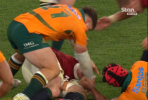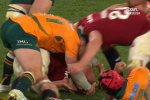JRugby2
Colin Windon (37)
Not in the official channel. Accepting I'm wrong with your point 2015 - we still likely need to see something like this, as there have been countless moments like that since that haven't been clarified publicly. Safe to say the fact they lost one of their most experienced referees shortly after doing so may have influenced their future actions.It has been queried though, the CEO is on record with this
And World Rugby did come out and confirm the Ref got it wrong in the 2015 QF Australia vs Scotland, so there is indeed precedence
What silence does = is confusion for all involved
World Rugby Passport - Law Clarifications
Sure it creates confusion - but confusion is an inevitable outcome because there isn't universal agreement right now as to what is the correct call. Say WR (World Rugby) did clarify this - anyone who previous believed the opposite to whatever position WR (World Rugby) landed on in this hypothetical will be confused as to why.
Trying to achieve absolute black in white in a game so dynamic is folly.


